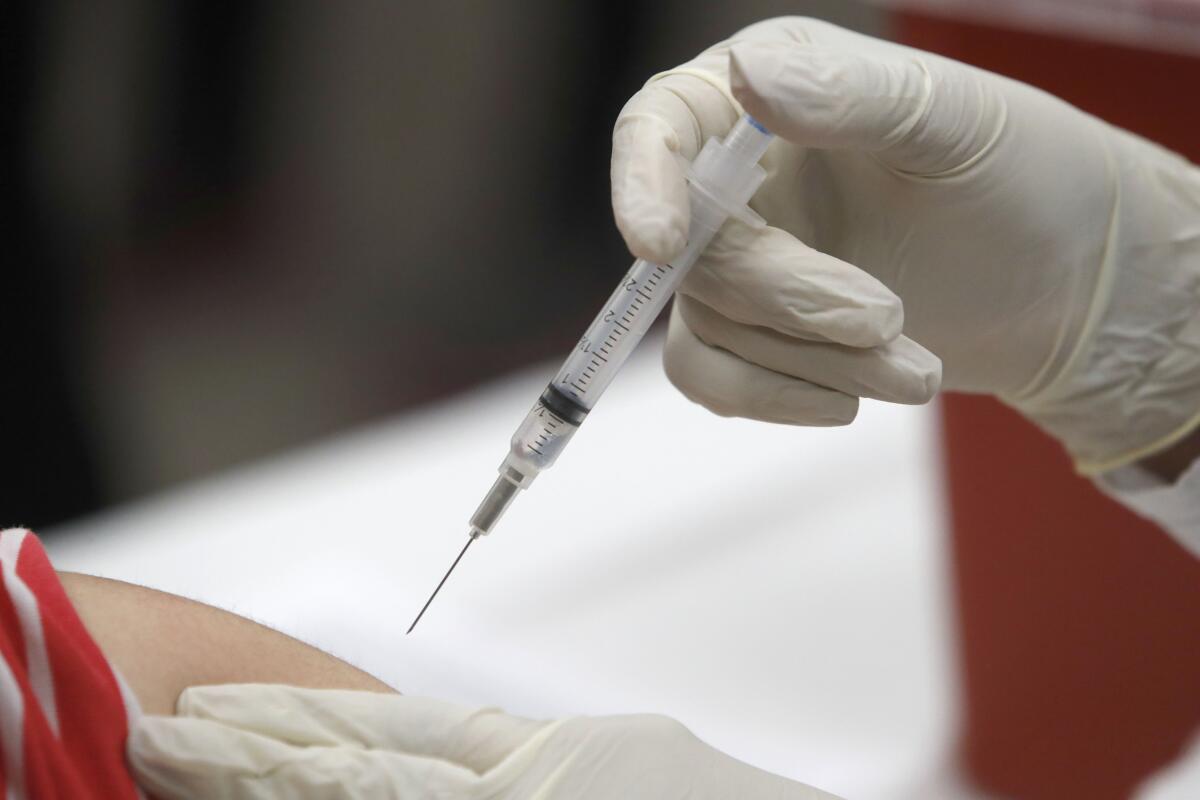It’s flu vaccine time, even if you’ve had your COVID shots

- Share via
Amid all the focus on COVID-19 vaccinations, U.S. health experts have another plea: Don’t skip your flu shot.
Flu cases have dropped to historically low levels during the pandemic. The U.S. and Europe experienced hardly any flu last winter, and the Southern Hemisphere just ended its second flu season of the coronavirus pandemic with little to report.
But with U.S. schools and businesses reopening, international travel resuming and far less masking this fall, the flu could make a comeback. The big question is whether it will trickle in or roar back and put extra pressure on hospitals already struggling with COVID-19 surges.
“People are sick to death of hearing about having to roll on out and get vaccines of any sort,” said flu specialist Richard Webby of St. Jude Children’s Research Hospital in Memphis, Tenn.
Yet, after 18 months of little influenza exposure, “we probably as a population don’t have as much immunity against this [season’s flu] virus as we typically might,” Webby said. “It makes absolute sense to go on out and get that vaccine and at least prepare for something that, you know, could be quite severe.”
Here are some things to know:
Who should get a flu vaccine?
The Centers for Disease Control and Prevention says just about everybody needs an annual flu vaccination, starting with 6-month-old babies. Influenza is most dangerous for adults over 65, young children, pregnant women and people with certain health conditions, such as heart or lung disease.
Why do I need one this year, since flu hasn’t been a threat during the pandemic?
COVID-19 restrictions including masking and staying home — especially for children, who are flu’s biggest spreaders — clearly had a side benefit of tamping down influenza and other respiratory bugs. But as soon as masks started to come off, the U.S. experienced an unusual summer surge of children hospitalized with a different virus named RSV that usually strikes in the winter. That’s a worrying sign of what to expect if flu returns.
What’s the forecast for flu this winter?
Flu is notoriously difficult to predict. But there’s a little more circulating in some countries this fall than last, including a recent uptick in China, said Webby, who directs a World Health Organization flu center. And people may be a little more vulnerable. Before the pandemic, 15% to 30% of the population was exposed to the flu each year. The decline in flu cases last season also meant the loss of a cyclical bump in immunity, he said.
“If flu does at least get a foothold in, it’s going to have more opportunity of spreading this season,” he said.
When should I get a flu vaccine?
Now. The CDC encourages people to get their vaccine by the end of October. Doctors’ offices, retail pharmacies and local health departments have millions of doses in hand. And most Americans with health insurance can get it with no co-pay.
I already got a COVID-19 vaccine. Do I really need a flu shot, too?
COVID-19 vaccines prevent the coronavirus and flu vaccines prevent influenza. They don’t overlap. But you can catch both viruses at the same time, or one after the other.
“Avoid the double whammy” and get both vaccines, advised the American College of Emergency Physicians. For now, COVID-19 vaccines are available for anyone 12 and older.
Flu vaccines aren’t as powerful as vaccines against some other diseases. But if people do get influenza after vaccination, they tend to have a much milder illness.
Can I get a flu vaccine and a COVID-19 vaccine at the same visit?
Yes, the CDC says it’s fine to pair a flu vaccine with either a primary COVID-19 shot or a booster dose.
What’s the best flu vaccine to get?
Flu constantly evolves, and each year’s vaccine is made to fight the strains that international experts deem most likely to circulate. This year, all the flu vaccines offered in the U.S. offer protection against all four of those strains.
Options include traditional shots or a nasal spray vaccine. There also are shots specifically designed to rev up seniors’ age-weakened immune systems, either with a higher dose or an added immune booster, and ones for people allergic to eggs, which are used to make some flu shots.
How much flu vaccine is available?
The CDC expects vaccine manufacturers to deliver 188 million to 200 million doses. Nearly 194 million doses were distributed last winter, a record.






